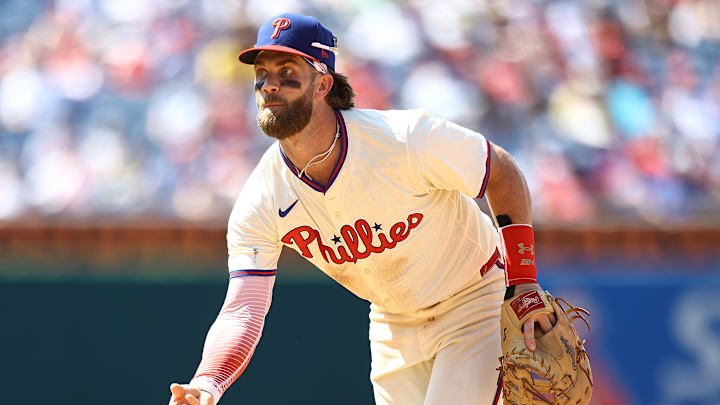It’s not rare to see a guy bump over to first base, especially as they age or their defense falters elsewhere. Miguel Cabrera was a third baseman until he got to the Tigers, Ernie Banks kicked over to first from short in the back half of his career, our good buddy Kyle Schwarber played first base for a season in Boston, and Albert Pujols dabbled at third and left field until finding a home at first (he also has one career appearance at shortstop, and I need to find that footage somehow).
So it isn’t unheard of for a guy to move over to first base like Bryce Harper did this year. The impressive part isn’t the move itself, it’s how good he has become at the position in such little time.
The thing that makes the Harper situation unique is that he didn’t NEED to become a first baseman. Sure, the injury had a lot to do with it, allowing him to come back and free up the DH spot for Kyle Schwarber in the postseason. But Harper was already a solid defensive right fielder and probably would be for a few more years (he certainly would be better than Nick Castellanos out there).
However, the Phillies liked what they saw from him at the end of the 2023 season and Dave Dombrowski decided to give him the reins there for the foreseeable future.
In theory, moving from third to first feels natural as the position is generally easier than the notably difficult hot corner. Let’s not forget that Harper came from the outfield, where you’re standing a good 250 feet away from the batter to field fly balls instead of the 90 feet away to field hot shots hit by lefty sluggers like Matt Olson and Shohei Ohtani.
He notably played catcher in high school and there have been videos of him taking ground balls at short during batting practice with the Nationals, but that’s just not the same as game situations when you’re a classically trained outfielder. Bryce has nailed the transition though, and most fans can attest that he passes the eye test.
Better yet, the advanced defensive metrics match what our eyes are telling us. For some people, you might not care about the advanced stats and metrics I use in the next paragraph, but that’s okay. I won’t get in-depth about them and all you need to know is that he’s grading out well in them and they are backing up the positive eye test.
First prediction of 2024: Bryce Harper wins National League Gold Glove Award at first base.
— PHILLIES BELL (@PhilliesBell) February 29, 2024
pic.twitter.com/cEhRGCShS4
Let’s start with his outs above average, where he is in the 94th percentile according to Baseball Savant. His five outs above average is tied for third in baseball with Michael Busch, behind only Christian Walker (who is perennially lauded for his defensive prowess) and Carlos Santana. Okay, so that’s good.
His arm doesn’t grade out all that impressively, but he is fresh off Tommy John and arm strength isn’t as important at first. Plus, we’ve seen him throw from right and know he has it in the tank when he needs it and his arm is fully healthy.
We’ll also look at defensive runs saved, the other big metric when it comes to defensive analytics. Harper has three defensive runs saved according to Fangraphs, which is top-10 in baseball this year. Also good. And finally, for those who like good old-fashioned errors, Harper has only two this year. However you want to slice the pie, Harper has been really good this year in a new position, which is not easy to do.
Top it all off with the fact that he’s still a great hitter and likely second in the MVP race behind Shohei Ohtani after the Mookie Betts injury shows that he hasn’t sacrificed any offense in the process. He has been the rock and the best player on this team and his willingness to change positions proves his team-centered mindset and desire to win in Philly.
Bryce Harper is on pace for 38 HR, 100 runs, 100 walks, 100 RBI, and playing a Gold Glove level first base.
— Joe Giglio (@JoeGiglioSports) June 22, 2024
This is the best he’s ever been in a Phillies uniform, including the 2021 MVP season.pic.twitter.com/drjxPhqDBW
